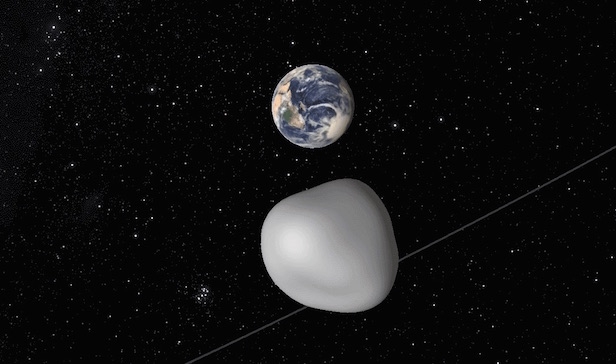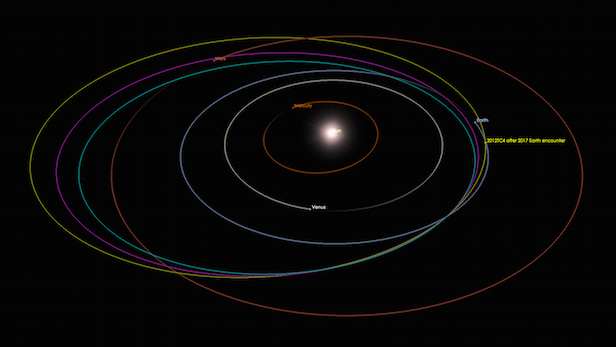First international test to track dangerous ‘Earth-destroying’ asteroids completed
The exercise was led by NASA scientists in a bid to test the International Asteroid Warning Network

The asteroid 2012 TC4 made its closest approach to Earth at a distance of roughly 43,780 kilometres (27,200 miles). Image credit: NASA/JPL-Caltech
An international team of astronomers led by NASA scientists successfully completed the first global exercise that tested the global response to a real asteroid. The planning for the “TC4 Observation Campaign” began in April of this year, as it observed the asteroid 2012 TC4 and tracked its trajectory towards Earth. The aim of this test was to recover, track and characterise a real asteroid as a potential impactor. Also, it was to test the International Asteroid Warning Network for hazardous asteroid observations, modelling, prediction and communication.
Asteroid 2012 TC4, the target of the exercise, is a small asteroid that was originally estimated to be between 10 and 30 metres (30 and 100 feet) in size and was known to make a very close approach to Earth in mid-October. On 12 October 2017, TC4 safely passed by Earth at a distance of roughly 43,780 kilometres (27,200 miles). In the months prior to this, astronomers from the United States, Canada, Colombia, Germany, Israel, Italy, Japan, the Netherlands, Russia and South Africa all tracked TC4 with ground-based and space-based telescope in order to understand it’s orbit, shape, rotation and composition.
“This campaign was an excellent test of a real threat case. I learned that in many cases we are already well-prepared; communication and the openness of the community was fantastic,” says Detlef Koschny, of the near-Earth object (NEO) segment in the European Space Agency (ESA)’s Space Situational Awareness program. “I personally was not prepared enough for the high response from the public and media — I was positively surprised by that! It shows that what we are doing is relevant.”
“The 2012 TC4 campaign was a superb opportunity for researchers to demonstrate willingness and readiness to participate in serious international cooperation in addressing the potential hazard to Earth posed by NEOs,” says Boris Shustov, of the Institute of Astronomy at the Russian Academy of Sciences. “I am pleased to see how scientists from different countries effectively and enthusiastically worked together toward a common goal, and that the Russian-Ukrainian observatory in Terskol was able to contribute to the effort.”
From these observations, scientists at NASA’s Centre for Near-Earth Object Studies (CNEOS) at the Jet Propulsion Laboratory in Pasadena, California were able to calculate the asteroid’s orbit and determine if it was an impact risk. “The high-quality observations from optical and radar telescopes have enabled us to rule out any future impacts between the Earth and 2012 TC4,” says Davide Farnocchia from CNEOS. “These observations also help us understand subtle effects such as solar radiation pressure that can gently nudge the orbit of small asteroids.”

2012 TC4’s heliocentric orbit (depicted in yellow) has changed due to the 2012 and 2017 close encounters with Earth. Image credit: NASA/JPL-Caltech
These efforts led to astronomers determining the rotation of TC4, which was expected to be rotating fast due to its small size. The astronomers were surprised to find out that not only did it spin once every 12 minutes, but it was also tumbling. “The rotational campaign was a true international effort. We had astronomers from several countries working together as one team to study TC4’s tumbling behaviour,” says Eileen Ryan of the Magdalena Ridge Observatory. Her team tracked TC4 for about two months using the 2.4-metre (7.9-foot) telescope in Socorro, New Mexico.
NASA’s Goldstone Deep Space Network antenna in California, and the National Radio Astronomy Observatory’s 100-metre (330-feet) Green Bank Telescope in West Virginia, collected the data necessary to confirm the shape and composition of the asteroid. TC4 was confirmed to be very elongated, as it was about 15 metres (50 foot) long and 8 metres (35 foot) wide.
Determining the asteroid composition proved to be a much trickier task because of the adverse weather conditions. Normally, NASA’s assets that study asteroid compositions – such as NASA’s Infrared Telescope Facility (IRTF) at the Mauna Kea Observatory, Hawai’i – were only able to narrow down TC4 to two possible compositions; either dark, carbon-rich or bright igneous material.
“Radar has the ability to identify asteroids with surfaces made of highly reflective rocky or metallic materials,” says Lance Benner of the JPL. “We were able to show that radar scattering properties are consistent with a bright rocky surface, similar to a particular class of meteorites that reflect as much as 50 per cent of the light falling on them.”
NASA also used this exercise as an opportunity to evaluate the communication between the many worldwide observers and the internal U.S. government communications. These internal U.S. communications ran through the executive branch and across government agencies, as it would during an actual predicted impact emergency.
Keep up to date with the latest reviews in All About Space – available every month for just £4.99. Alternatively you can subscribe here for a fraction of the price!




